The Role of Carbon Fibre Masts in Kiteboarding Equipment
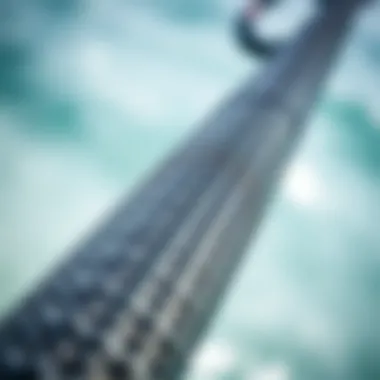
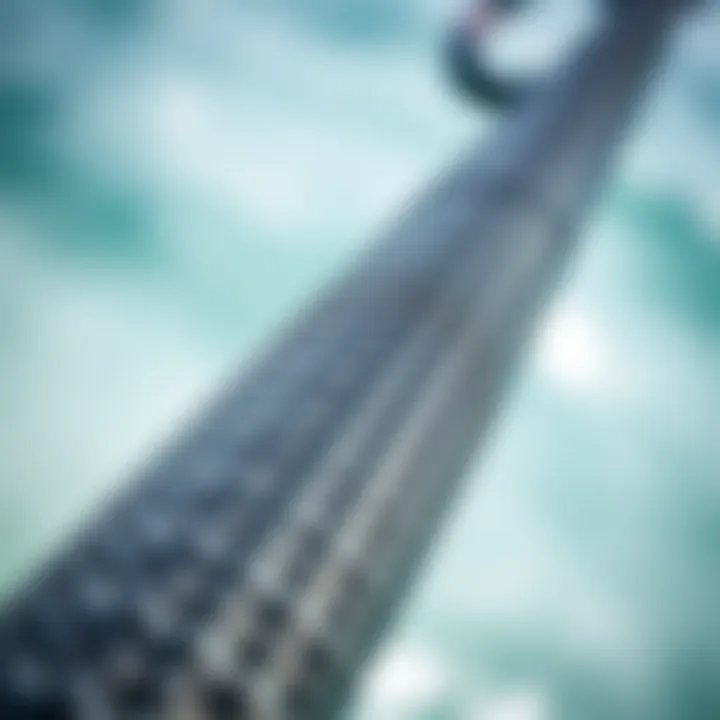
Intro
Kiteboarding has seen its fair share of innovations over the decades, but one of the most game-changing advancements has undoubtedly been the advent of carbon fibre masts. These sleek, lightweight constructions have made their presence felt in the world of kiteboarding, resulting in significant boosts in performance and maneuverability. Not a moment goes by when kiteboarders don't marvel at how these masts have reshaped the way they ride the waves and dance with the wind.
But what makes carbon fibre a top pick for kiteboarding gear? This article dives deep into the properties that set it apart from traditional materials, exploring the intricate engineering behind its strong yet elastic structure. Beyond just performance, we’ll examine how these advancements have a ripple effect on the wider kiteboarding community, guiding both enthusiasts and instructors to adapt and evolve.
In the backdrop of each thrilling ride sits a wealth of knowledge regarding sustainable practices and maintenance strategies for carbon fibre equipment. The unexpected challenges, market dynamics, and environmental considerations fall into our purview as we navigate this transformative landscape.
Aimed at kiteboarders, instructors, and water sports coaches, our journey through the world of carbon fibre masts promises to be enlightening, packed with insights and technical details that not only showcase the advantages but also illuminate the drawbacks associated with these high-tech components.
Foreword to Carbon Fibre Technology
Carbon fibre technology stands at the forefront of innovations that significantly alter the landscape of various industries, kiteboarding being a prime example. The material is revered not just for its impressive strength-to-weight ratio but for its versatility as well. This introductory section aims to illuminate the significance of carbon fibre masts in kiteboarding, considering how they contribute to enhanced performance and excitement on the water, as well as the considerations that come into play when adopting this advanced technology.
Understanding Carbon Fibre
Carbon fibre consists of extremely thin strands of carbon atoms, tightly woven and bonded together to form a material that is not only lightweight but also incredibly strong. The way carbon fibres are engineered allows them to bear heavy loads while maintaining a reduced weight, which is crucial for kiteboarding equipment where every ounce counts. For kiteboarders, this means they can ride faster and with greater agility.
When it comes to kiteboarding specifically, a carbon fibre mast offers unprecedented performance benefits. Its lightweight nature enhances the board's responsiveness to various conditions—anything from sudden gusts of wind to the subtle shifts in water currents. It's like upgrading from a reliable old sedan to a high-performance sports car; the sheer thrill and efficiency make it worth the investment. This material enables riders to achieve enhanced aerial tricks and smoother transitions, leaving behind the bulky, less responsive masts of yesterday.
Historical Development of Carbon Fibre
Now, let’s stroll down memory lane to see how carbon fibre came to be a mainstay in kiteboarding. The journey of carbon fibre technology began in the 1950s, with early developments focused on aerospace and high-performance automotive applications. Its introduction to the water sports realm didn’t happen overnight. Kiteboarding, in its infancy, relied heavily on traditional materials like fiberglass and aluminum, which often hampered performance.
The shift towards carbon fibre started gaining momentum in the 1990s. Initially, kiteboarding enthusiasts experimented with using carbon fibres in several components, leading to prototype boards and kites. By the early 2000s, manufacturers realized the potential for carbon fibre to completely change the dynamics of kiteboarding. As the technology progressed and production processes became more refined, carbon fibre masts started appearing in kiteboarding shops.
This evolution reflects not just a technological advancement but also a cultural shift within the kiteboarding community toward seeking higher performance and pushing the envelope of what is possible in the sport. More than just a material, carbon fibre became synonymous with innovation and the pursuit of excellence on the water. As riders began to experience its unique advantages, word spread through the surf and skate communities, sparking interest and further development.
In summary, understanding carbon fibre technology and its historical context provides valuable insights for kiteboarders, instructors, and coaches alike. This background makes it easier to appreciate the performance-enhancing capabilities that carbon fibre masts bring to the table, marking a fertile ground for future innovations and advancements in kiteboarding gear.
Properties of Carbon Fibre
The incorporation of carbon fibre into kiteboarding equipment marks a transformative leap in performance and functionality. This section elucidates the essential properties of carbon fibre—strength and durability, lightweight characteristics, and the balance between flexibility and rigidity—all of which play a crucial role in how kiteboarders experience the sport.
Strength and Durability
Carbon fibre is renowned for its astonishing strength-to-weight ratio. This material can withstand strong forces while remaining feather-light, which is particularly advantageous for kiteboarding. The strength of carbon fibre arises from its unique molecular structure. Individual carbon atoms bond together to form long chains, leading to an extremely robust composite. Unlike other materials that experience fatigue over time, carbon fibre maintains its integrity under stress.
Moreover, its durability means that kiteboarders can push their limits without fear of damaging their equipment. Consider a kiteboarding session filled with robust winds; the mast's ability to resist breaking under duress significantly enhances the rider's confidence. Some riders have reported masts enduring impacts and conditions that would typically leave traditional materials shattered.
Lightweight Characteristics
When it comes to performance in kiteboarding, every gram counts. Carbon fibre excels in producing lightweight masts, making it a top choice for serious kiteboarders. The lightness of the mast translates to amplified agility on the water. Riders equipped with carbon fibre masts often notice a marked increase in their ability to maneuver swiftly, especially during jumps or sudden turns.
Lightweight constructions also contribute to ease in setting up and handling equipment. A kiteboarder lugging around heavy gear quickly learns to appreciate the difference between carbon fibre and heavier alternatives. Because of this characteristic, many compete at a higher level, as the reduced weight can lead to better overall performance, transforming physical exertion into exhilarating glide.
Flexibility vs Rigidity
A pivotal factor in the performance of carbon fibre masts is finding the balance between flexibility and rigidity. This interplay often dictates how the kite responds to various wind conditions. Generally speaking, more flexible masts allow for improved control and responsiveness, while rigid masts can result in enhanced stability and power.
In kiteboarding, the relationship between flexibility and rigidity has direct implications on performance metrics. A mast that is too flexible might lead to unwanted flapping or instability during high-speed runs. Conversely, if a mast is excessively rigid, it can feel unyielding, potentially compromising rider comfort and control. Modern carbon fibre constructions often implement innovative designs that offer an optimal blend. Riders can enjoy the best of both worlds—a mast that provides stability while still allowing for quick adjustments as conditions demand.
"Kiteboarding is as much about intuition as it is about gear. The right balance in mast properties can elevate a good ride into a great one."
Understanding these properties of carbon fibre masts is crucial for kiteboarders who wish to maximize their experience on the water. Strength, weight, and the ideal balance between flexibility and rigidity culminate in a performance-oriented design that supports both novice and seasoned riders alike.
Advantages of Carbon Fibre Masts in Kiteboarding
Carbon fibre masts have transformed the kiteboarding experience by offering a plethora of advantages that set them apart from traditional materials. In this section, we'll explore key benefits like performance enhancements and long-term cost efficiency. Understanding these details can help kiteboarders make informed decisions about their equipment, particularly as interest in advanced materials continues to grow.
Performance Enhancement
Speed and Agility
When it comes to kiteboarding, speed and agility are crucial. Carbon fibre masts excel in these areas due to their lightweight nature. The materials used in carbon fibre allow for reduced weight without sacrificing strength, which means that kiteboarders can achieve greater velocity with less effort. This also facilitates quicker maneuvers that are necessary when navigating through changing wind conditions or during competitive racing.
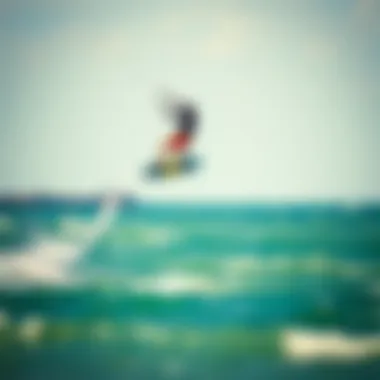
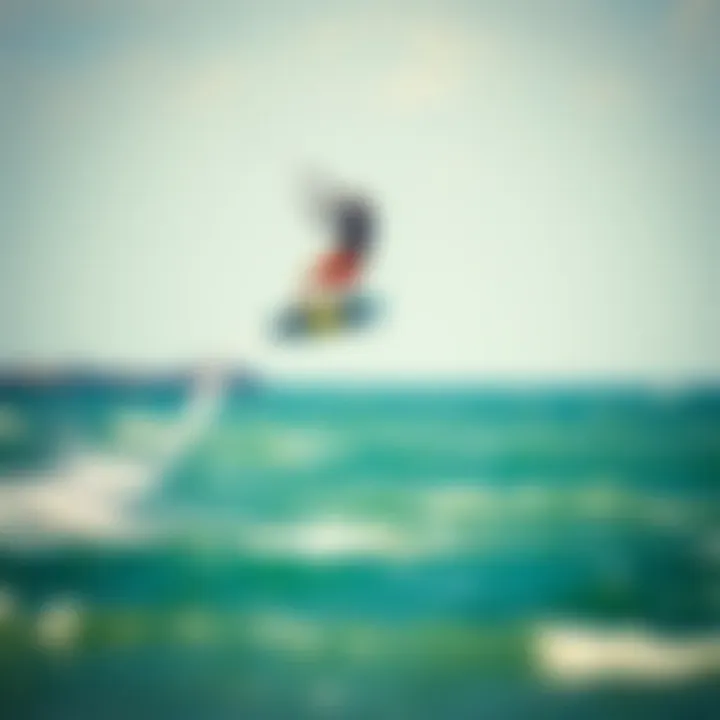
A standout feature of speed afforded by carbon fibre is its ability to respond to shifts in wind direction, enhancing the rider's overall agility. Traditionally, masts made from heavier materials might dampen performance, making it harder for riders to make split-second adjustments. The result? Riders can harness the wind more effectively, speeding past their competition while executing sharp turns.
"The reduction in weight allows for a more dynamic riding experience, making it easier to carve and race."
Stability in Varied Conditions
Stability in varied conditions is another area where carbon fibre masts shine. They possess a unique ability to withstand strong winds without compromising structural integrity. This means that when kiteboarders face challenging environments, such as choppy waters or gusty winds, they can still experience a consistent and controllable ride.
Carbon fibre masts are engineered to absorb vibrations effectively, which decreases the likelihood of wobbling or uncontrolled movements. This stability enhances rider confidence, encouraging them to push their limits. A robust mast provides the necessary support to maintain balance while providing consistent power, essential for maximising performance during unpredictable winds.
Long-Term Cost Efficiency
Despite the higher initial investment, carbon fibre masts offer long-term cost efficiency that often makes them the more attractive option for serious kiteboarders. Their durability ensures that they can withstand the rigors of kiteboarding over extended periods, proving less prone to wear and tear than their fiberglass or aluminium counterparts.
Investing in carbon fibre means fewer replacement costs and a reduced need for extensive repairs. This is particularly advantageous for enthusiastic kiteboarders who regularly hit the waves. As a result, although the upfront price tag might raise eyebrows, savvy riders recognise the long-term financial benefits of going with carbon fibre.
In summary, the advantages of carbon fibre masts—enhanced performance through speed and stability, paired with long-term cost efficiency—make them a preferred choice in kiteboarding today. With kiteboarding evolving significantly, staying ahead with the best equipment can not only improve individual performance but also elevate the overall experience on the water.
Disadvantages of Carbon Fibre Masts
In the pursuit of excellence in kiteboarding, carbon fibre masts often rise to the top with their advanced properties and performance enhancements. However, like any innovation, they come with their own set of downsides. It’s essential to address the disadvantages of these masts as they form an integral part of understanding the bigger picture. By highlighting these limitations, potential buyers, enthusiasts, and professionals can engage in informed decision-making about kiteboarding equipment.
Higher Initial Investment
Perhaps the most glaring issue with carbon fibre masts is their higher initial cost. While the long-term benefits may justify the investment, the entry price can be quite steep for many kiteboarders. For those who are just dabbling in the sport or are on a budget, the price tag can be a serious hurdle. A carbon fibre mast can run several hundred to even thousands of dollars, depending on design and specifications.
- Expenditure: This raises important questions about the allocation of resources. For some riders, spending a significant chunk of their budget on just the mast can mean cutting corners on other critical gear, like kites or safety equipment.
- Market Entry: For newcomers in the sport, such a financial barrier can dissuade them from taking the plunge into the exhilarating world of kiteboarding altogether. Understanding this context shifts the perspective from merely appreciating the gear to evaluating the overall accessibility of the sport.
Despite its advantages, the upfront cost can discourage those who might otherwise fully enjoy the experience of kiteboarding.
Potential for Damage
Another issue that deserves attention is the potential for damage associated with carbon fibre masts. While these masts are built to withstand stress and perform admirably in the water, no material is entirely free from the risk of wear and tear. The lightweight nature of carbon fibre, while a benefit for performance, also makes it somewhat vulnerable to certain types of impacts.
- Fragility: Unlike their aluminium counterparts, which can endure substantial bending without losing integrity, carbon fibre can crack or splinter when subjected to hard impacts. A simple misjudgment during handling or storage could lead to irreparable damage.
- Repair Challenges: Additionally, repairing a damaged carbon fibre mast can be more complex and costly than repairing other materials. Finding a qualified technician with experience in carbon repairs may not be straightforward, which complicates the maintenance process.
As a result, while carbon fibre masts offer remarkable performance, they demand a higher level of care and respect in terms of handling and maintenance. Riders must weigh these factors against the advantages when considering the investment in suchmasts.
It’s all about balance; the infrastructure of your kite setup should be a synergy of performance, durability, and practicality.
Comparison with Other Mast Materials
The discussion surrounding the materials used in kiteboarding masts is essential for any enthusiast looking to elevate their experience on the water. This section peeks into how carbon fibre stacks up against traditional materials like fiberglass and aluminum. Both versatility and performance play a crucial role in this comparison, influencing decisions for kiteboarders from all walks of life.
Fiberglass vs Carbon Fibre
Performance Differences
When comparing fiberglass to carbon fibre, performance is where the differences are most prominent. Fiberglass masts generally offer ample flex and a degree of toughness that many beginners appreciate, as they can withstand some serious abuse during learning phases. However, they fall short in providing that snappy responsiveness that advanced riders seek. Carbon fibre, on the other hand, stands out for its stiffness and strength. This characteristic allows for quicker ride responses and sharper turns, which are vital for performance-oriented riders.
The unique feature here is the capacity of carbon fibre to absorb vibrations while maintaining structural integrity—essential for handling choppy waters with finesse. Riders who opt for carbon fibre often find themselves gaining speed and agility, enhancing their overall performance, especially in competitive settings.
Cost Comparison
Moving onto the cost aspect, fiberglass initially seems like a more budget-friendly option. However, a closer look reveals that carbon fibre’s long-term value may justify the higher upfront cost. Simply put, while fiberglass masts are easier on the wallet at purchase, they often require replacements or repairs more frequently than carbon options due to wear and tear. The durability of carbon fibre can make it a more economical choice in the long run, despite its higher initial price tag.
Essentially, you get what you pay for; investing in carbon can lead to savings if a rider intends to stay in the sport for a while. Though both materials have their merits, carbon fibre offers unique advantages suitable for those who prioritize performance and longevity.
Aluminium vs Carbon Fibre
Weight Considerations
Weight is often one of the foremost considerations when choosing a mast material. Aluminium masts typically weigh more than carbon fibre, making them less appealing to serious kiteboarders. The lighter construction of carbon fibre means improved maneuverability and reduced fatigue during long sessions on the water. Kiteboarders often find that less weight translates into enhanced flight and better control.
While aluminium has its benefits such as affordability and durability, those looking to refine their technique and enjoy effortless rides often lean toward the featherlight feel of carbon fibre.
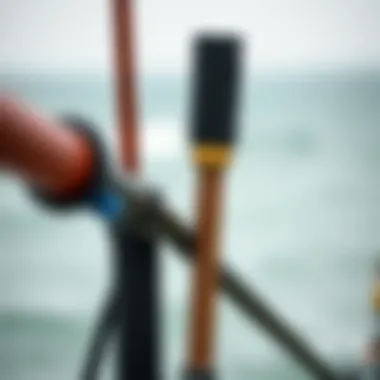
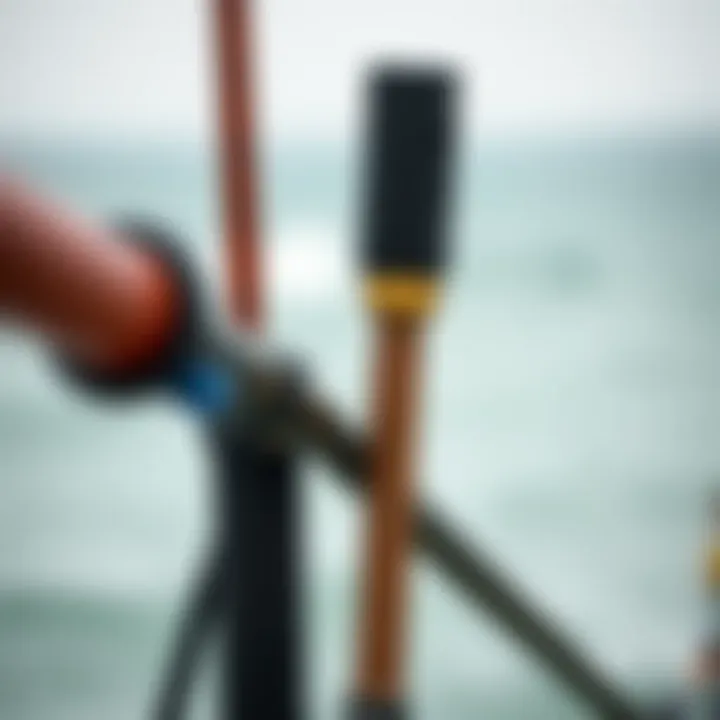
Durability Factors
Durability is a substantial factor that further distinguishes carbon fibre from aluminium. While aluminium generally holds up well under regular use and does not suffer from as many catastrophic failures, it can bend or dent, which might lead to structural weaknesses over time. Carbon fibre, however, while sometimes more brittle, is engineered to withstand high-performance scenarios, maintaining its integrity significantly longer in the right hands.
The unique quality of carbon fibre is its resistance to corrosion, an essential feature for those who regularly encounter saltwater. For those determined to push their limits, the durability provided by carbon fibre could very well justify its higher price. In challenging conditions, this material proves its worth, becoming an indispensable ally for performance-driven kiteboarders.
Engineering Insights into Carbon Fibre Masts
In the fascinating world of kiteboarding, the engineering behind carbon fibre masts represents a significant leap in design and functionality. Carbon fibre is not merely an advanced material but a game-changer, influencing various aspects of kiteboarding equipment. To grasp its full impact, we need to explore the manufacturing processes that give carbon fibre its unique properties and the technological advances that continue to shape its evolution.
Manufacturing Processes
The way carbon fibre masts are made involves both art and science. At the heart of it, the manufacturing processes rely on a combination of precision engineering and innovative techniques. The key stages in producing carbon fibre masts include:
- Preparation of Carbon Fibres: The raw materials are laid out into sheets, either as unidirectional or woven fabric, tailored to provide specific characteristics suited for performance.
- Resin Infusion: This step involves saturating the carbon fibre with resin, often epoxy, which binds the fibres and adds structural integrity. The chosen resin type influences the mast’s strength and weight, so it’s crucial to pick the right one.
- Molding: Using molds shaped to create the desired mast profile, the resin-saturated fibres are laid in layers. This process demands precision to ensure that the final product will perform consistently across various conditions.
- Curing: The finished assembly is placed in an oven or heated environment to cure, solidifying the mast's structure. This process is critical as it determines the overall quality and performance capabilities.
Each of these processes contributes to the remarkable performance characteristics of carbon fibre masts, aligning them with the diverse needs of kiteboarders. From novice to pro, users can benefit from masts that transfer energy efficiently, resist bending, and have an excellent stiffness-to-weight ratio.
Technological Advances
The journey of carbon fibre masts in kiteboarding doesn’t stop at traditional manufacturing processes. Recent technological advancements are drastically redefining what’s possible:
- 3D Printing: Although still in its infancy regarding mass production, 3D printing is beginning to play a role in creating prototype masts. It allows designers to create complex geometries that traditional molding techniques can’t achieve.
- Smart Materials: The integration of sensors within the mast can lead to real-time performance analytics. Imagine having the ability to receive feedback on mast flex and stress as you ride. Such insights can guide adjustments, optimizing performance on the go.
- Sustainability Initiatives: There’s a growing trend towards using recycled carbon fibres. Innovative companies are exploring ways to source material from outdated or damaged equipment, reducing waste and lowering the environmental impact.
These technological strides not only push the performance envelope but also encourage a more sustainable approach to kiteboarding equipment. For the modern kiteboarder, this means more eco-friendly choices without sacrificing performance—an essential consideration in today's market.
"The continuous evolution of carbon fibre technology is not just an advancement in materials; it’s a transformation in how we experience kiteboarding."
The engineering insights into carbon fibre masts shed light on their intricate manufacturing processes and the cutting-edge developments shaping their future. Through these lenses, we can appreciate the significant role that innovation plays in enhancing the sport, making each session on the water a thrilling experience.
The Impact of Carbon Fibre Masts on Kiteboarding Performance
The impact of carbon fibre masts in kiteboarding cannot be overstated. These high-tech poles symbolize a major leap in performance, revolutionizing how enthusiasts engage with the water. The kiteboarding community has evolved substantially, and carbon fibre has played a pivotal role in shaping the experience experienced by riders. The benefits encapsulated in these masts stretch beyond mere numbers; they translate into profound changes in how kiteboarders navigate the wind and the water.
User Experience and Feedback
When it comes to user experience, carbon fibre masts have garnered predominantly positive feedback among kiteboarders. Riders often talk about the increase in control and responsiveness when using these lightweight materials. The feeling of less drag while tearing through waves makes all the difference during a high-speed run. Many enthusiasts have noted that with carbon fibre, subtle shifts in body weight elicit a rapid response from the kite, allowing for better maneuverability in varying conditions.
Also, personal narratives from kiteboarders emphasizing how carbon masts improved their performance are common. From weekend warriors to seasoned professionals, many agree that switching to carbon fibre has led to enhanced overall enjoyment, less fatigue during longer sessions, and the ability to tackle more challenging wind conditions.
Here are some user-reported benefits after the switch to carbon fibre masts:
- Quicker acceleration: Riders experience faster take-offs and quicker adjustments in the air.
- Improved stability: The reduced weight helps maintain a steady flight path, especially when faced with gusts.
- Less fatigue: Many riders have remarked on how using lighter masts reduces strain over extended periods on the water.
It's not just the newbies feeling the effects; veterans are also making the leap, constantly pushing their limits, adding fuel to the fire of innovation in kiteboarding.
Performance Metrics
In the realm of performance metrics, carbon fibre masts shine bright compared to traditional materials. Quantitative data has been gathered across various testing environments, demonstrating the superiority in quite a few aspects. Here are some notable factors:
- Weight Distribution: Carbon fibre masts, being significantly lighter than aluminium or fiberglass, can drastically reduce the overall weight of a kite setup. Less weight translates to increased lift and reduced drag.
- Flex Dynamics: The stiffness and flex characteristics of carbon fibre allow for versatility in performance. When under load, these masts distribute forces evenly, converting energy more efficiently, which aids in enhanced power delivery while riding.
- Durability Testing: Rigorous durability tests show that even though carbon is light, it handles extreme conditions better. Unlike aluminum, carbon fibre does not deform easily when subjected to high-stress loads, maintaining structural integrity over time.
Care and Maintenance of Carbon Fibre Masts
Taking good care of your carbon fibre mast is like putting a safeguard around your investment. In kiteboarding, having a dependable mast can make or break your experience on the water. Given that carbon fibre is a premium material, maintaining it ensures not just longevity but also consistent performance.
Regular maintenance can help prevent minor issues from becoming major headaches. These masts are designed for strength, but they’re not indestructible. Knowing the ins and outs of care practices can keep your kiteboarding escapades smooth. This section unravels the essentials of mast maintenance.
Routine Inspection Practices
Regular inspections are the backbone of maintenance for carbon fibre masts. Just like you wouldn’t jump into a road trip without checking your tires, it's crucial to routinely inspect your mast for signs of wear and tear. Here are some vital practices to ensure your mast remains in top-notch condition:
- Visual Checks: After each session, take a close look at your mast. Look for cracks, scratches, or any irregularities. If you spot any damage, it’s better to address it sooner rather than later.
- Touch and Feel: Run your hands along the mast. Any unusual rough spots or delaminated areas can affect performance. Feel for any soft spots that shouldn't be there.
- Hardware Inspection: Don’t forget about the fittings and pins. Ensure everything is rust-free and securely fastened. Loose connections can lead to dramatic failures while out on the water.
"Prevention is better than cure. Regular checks can save you from losing control while kiteboarding and can extend the life of your equipment."
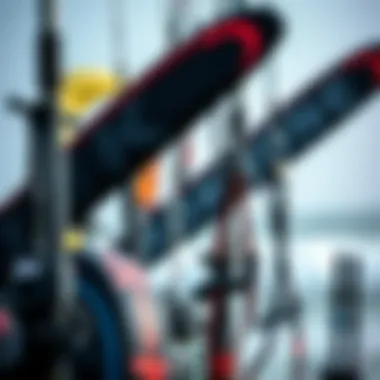

Repair Techniques
If wear or damage is found during inspections, having the right know-how for repairs is crucial. Repairing carbon fibre correctly can get you back on the water without the hefty price tag of a new mast. Here are a few common methods:
- Epoxy Resin Repairs: For small cracks or scratches, applying epoxy resin can be an effective fix. Clean the area, mix the resin according to the instructions, and apply it carefully. Make sure to sand down the repaired area once cured for a smooth finish.
- Reinforcement: For larger cracks, it might be wise to reinforce the mast with additional layers of carbon fibre. This involves cutting a piece of new carbon fibre cloth and applying it over the damaged area with resin.
- Professional Help: Sometimes, it’s best to let the pros handle it. For major issues, contacting a repair specialist experienced with composite materials ensures that your mast gets the attention it needs.
Market Trends in Kiteboarding Equipment
Understanding the evolving landscape of kiteboarding equipment is critical, not just for enthusiasts, but also for manufacturers and retailers looking to align with consumer needs. As kiteboarding grows in popularity, so do the expectations and preferences of its users, particularly regarding the materials they opt for. The shift towards carbon fibre masts is a testament to this trend. This segment delves into the key aspects shaping market dynamics, such as consumer preferences and the pressing consideration of sustainability.
Consumer Preferences
Consumer preferences in kiteboarding gear largely reflect individual riding styles and performance aspirations. This is particularly true when it comes to the choice of mast material. Many kiteboarders gravitate towards carbon fibre due to its unmatched strength-to-weight ratio, which can enhance performance significantly. In a sport where every ounce of weight matters, athletes often seek gear that maximizes speed and agility.
Some trends have emerged in feedback and surveys:
- Performance-driven choices: Riders are increasingly prioritizing performance over cost. They are willing to invest in high-quality carbon fibre masts that promise improved responsiveness and longevity.
- Brand loyalty: Established brands like Duotone and Cabrinha have successfully built reputations based on quality and innovation. Users often prefer gear from these brands, valuing their history of reliability.
- Customization and personalization: Kiteboarders are looking for gear that allows them to express their personal style. This includes everything from mast color options to personalized sizes that cater to individual preferences.
In summary, consumers’ evolving priorities are forcing manufacturers to adapt quickly. Those who can anticipate or respond to these desires will likely thrive in an increasingly competitive market.
Impact of Sustainability
The kiteboarding community, especially among younger enthusiasts, is showing a heightened awareness of environmental issues. Sustainability is becoming a pivotal consideration in the purchasing decisions of consumers. Increasingly, they are advocating for products that are not just high-performing but also eco-friendly.
The impact of sustainability on the kiteboarding market can be outlined through several key points:
- Eco-conscious materials: There’s a growing shift towards using recycled materials in manufacturing, with some brands experimenting with eco-friendly resins in their carbon fibre production processes.
- Lifecycle considerations: Consumers are now looking at the entire lifecycle of kiteboarding gear. Those that offer repair services or recycling options are becoming more attractive, as they align with the values of environmentally aware users.
- Education and advocacy: Brands are utilizing platforms like social media and community events to raise awareness about sustainable practices. Sharing information about how their manufacturing processes and materials are less harmful to the environment resonates well with today’s customers.
"Riding the wave of sustainability not only shows a brand’s commitment to our planet but also resonates deeply with the evolving values of our community."
By keeping sustainability at the forefront, the kiteboarding industry isn’t just responding to market demand; it’s also paving the way for a more responsible future. Ultimately, those in the kiteboarding world must consider how these market trends will influence not only what products they buy but also how they engage with the sport as a whole. The intertwined future of carbon fibre masts and sustainability could well define the next chapter in kiteboarding.
Future of Carbon Fibre in Kiteboarding
The future of carbon fibre in kiteboarding holds immense promise, as it melds the agility of cutting-edge technology with the passion for water sports. With kiteboarding continuously evolving, carbon fibre masts are set to play an integral role in enhancing both performance and user experience, catering to the growing demands of riders at all levels. As we dive deeper into this topic, it’s important to discuss the innovative designs on the horizon and explore potential avenues for future research and development.
Innovative Designs on the Horizon
The design landscape for carbon fibre masts is shifting towards innovation that not only amplifies performance but also enhances user comfort. One trend garnering attention is the integration of adaptive materials that can adjust their properties depending on the conditions.
Imagine a mast that could physically alter its stiffness or flexibility on demand based on wind strength. This could provide kiteboarders with tailored support under all conditions, from gentle breezes to robust storms. Additionally, manufacturers are considering aesthetic aspects too, focusing on sleek designs that reflect the rider's personality and preferences without compromising performance. This way, functionality and style go hand in hand.
As these designs materialize, kiteboarders can expect lighter, more responsive masts with optimized profiles that harness wind energy more effectively. Furthermore, the exploration of hybrid structures, integrating carbon fibre with other advanced materials, may lead to new levels of durability and performance. The innovation never stops; there's always a new idea popping up like a cork in water.
Potential for Research and Development
The potential for research and development in carbon fibre kiteboarding masts cannot be understated. Researchers and engineers are already hard at work discovering new applications and enhancements that go beyond mere performance metrics. One critical area is the study of environmental impact, as sustainability becomes increasingly central to manufacturing processes.
Advancements in recycling technologies for carbon fibre are being actively pursued. This would allow manufacturers to reclaim materials from older gear, minimizing waste and supporting eco-friendly practices in kiteboarding. Additionally, understanding the long-term effects of wear and tear on carbon fibre can lead to innovative coatings or treatments that prolong the life of these masts further, ensuring that cost-effective solutions can be realized for riders.
Moreover, improved testing methods using simulations and virtual reality can facilitate faster prototyping and adjustments. This would allow designers to fine-tune their products in a digital realm before moving to physical iterations, saving both time and resources. Collaborations between kiteboarding communities and engineering experts can stimulate ideas that may have been overlooked, creating a synergy where creativity meets technology, paving the way for dynamic advancements in the sport.
Finale
The exploration of carbon fibre masts in kiteboarding reveals a fascinating trajectory of innovation and advancement. As we wrap up this significant discussion, it’s crucial to ponder on a few key aspects that underline the importance of this topic.
Summation of Findings
Throughout the article, we have dissected various dimensions regarding carbon fibre masts. First, the material’s inherent properties—its strength, lightness, and rigidity—create a superior alternative to traditional materials. Kiteboarders experience clear benefits, such as improved performance metrics and agility on the water, making each ride exhilarating and dynamic.
In evaluating the advantages, the initial investment in carbon fibre masts can seem steep; however, their longevity and performance yield cost efficiency that merits serious consideration. Those who prioritize performance, know that user feedback overwhelmingly supports the transition from older mast materials, showcasing tangible enhancements in both speed and stability.
On the other side, it is equally important that we recognize the disadvantages such as the potential for damage and the associated repair costs, which can be a deterrent for some. This dichotomy emphasizes the delicate balancing act kiteboarders must navigate when choosing their equipment.
Final Thoughts on Carbon Fibre Tech
The journey of integrating carbon fibre into kiteboarding is far from over. As manufacturers continue to innovate and refine production processes, we stand at the cusp of further breakthroughs. With ongoing research on material properties and performance optimization, future developments promise not just enhancements but perhaps a revolution in the way we think about kiteboarding equipment.
Kiteboarders, instructors, and coaches alike should embrace this forward-thinking mindset and stay informed. The implications of adopting carbon fibre technology extend beyond just performance enhancements; they tie into broader shifts in consumer preferences toward sustainability and innovation in water sports equipment.
"Adapting and evolving is part and parcel of kiteboarding—carbon fibre is yet another chapter in this narrative of continuous improvement."















